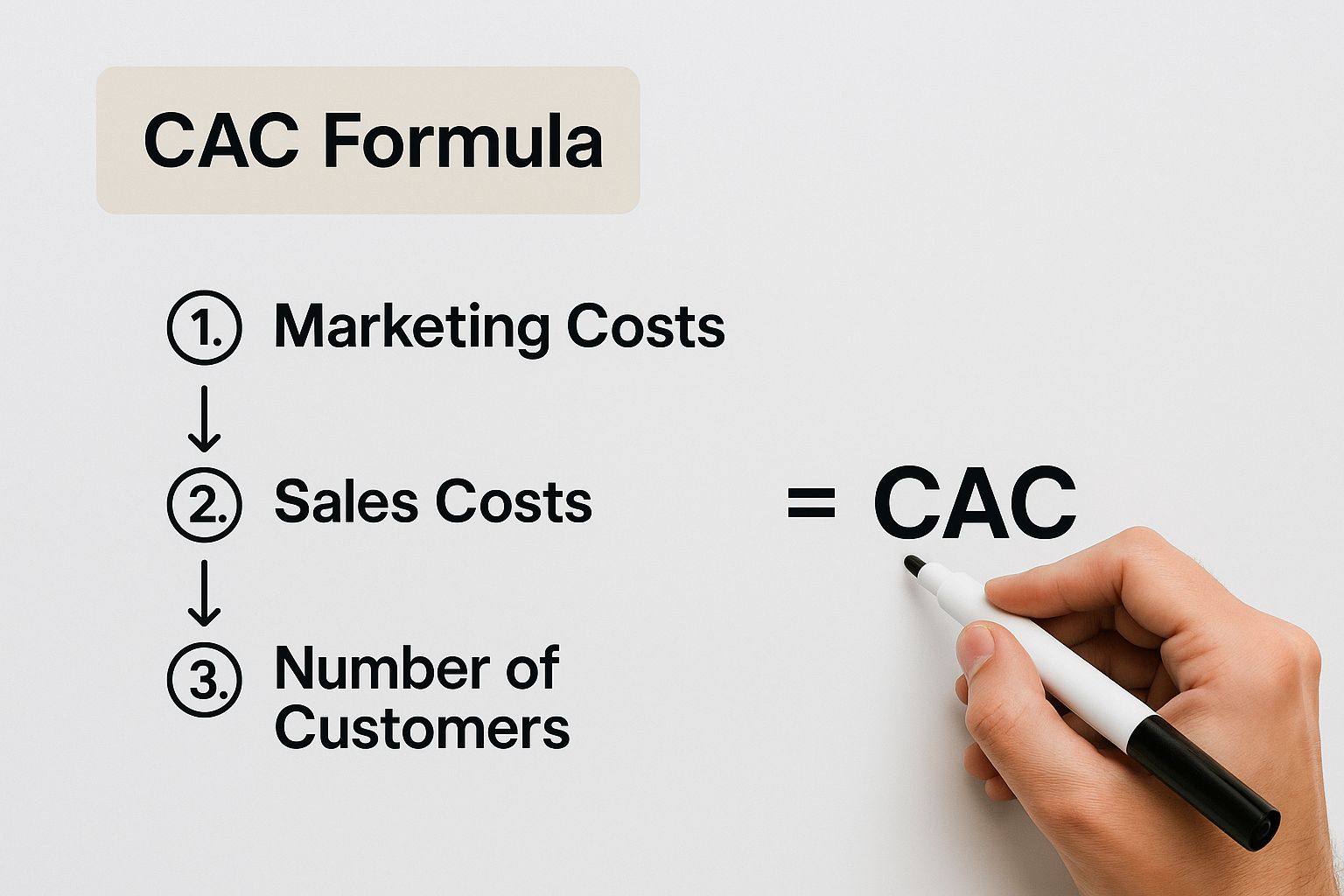At its core, the customer acquisition cost formula is straightforward: divide your total sales and marketing spend by the number of new customers you brought in over a set time. This simple calculation gives you the exact dollar amount it costs to win over each new buyer. Knowing this number isn't just a marketing exercise; it's the foundation of a profitable, sustainable business.
What CAC Really Tells You About Your Business

Think of CAC as a critical vital sign for your company's health. It’s a direct indicator of whether your business model can actually survive in the long run. After all, if you're spending $500 to acquire a customer who only ever brings in $100 of revenue, you've got a leaking bucket that needs immediate attention.
A firm grasp on your CAC informs decisions that ripple through the entire organization, not just the marketing department. It’s the key to answering questions like:
- Where should we allocate our budget for the best return?
- Are our marketing campaigns actually making us money?
- Is our pricing high enough to cover acquisition costs and still leave a healthy profit?
- Can we scale the business without going broke on every new customer?
Identifying the True Costs
Getting an accurate CAC means you have to be brutally honest about every single expense that goes into winning a new customer. This is way more than just what you spend on ads. The competition for customer attention is fierce, and costs have skyrocketed—in fact, CAC has jumped by an estimated 222% since 2013. This makes precise tracking more crucial than ever.
One of the biggest mistakes I see businesses make is forgetting to include team salaries or software subscriptions in their CAC calculation. These are substantial, recurring costs directly tied to your acquisition efforts and leaving them out gives you a dangerously misleading number.
To get a truly accurate figure, you need to tally up all the moving parts. This includes everything from ad spend to the salaries of the people running the campaigns.
Essential Costs for an Accurate CAC Calculation
Here’s a breakdown of the typical sales and marketing expenses you absolutely must include.
| Cost Category | Examples of Expenses |
|---|---|
| Advertising Spend | Paid search (Google Ads), social media ads (Facebook, Instagram), display ads, etc. |
| Team Salaries | Salaries and benefits for your marketing and sales teams. |
| Content Creation | Costs for writers, designers, video producers, and other content-related expenses. |
| Technical Stack | Subscriptions for CRM, marketing automation, analytics tools, and SEO software. |
| Publishing & Distribution | Fees for press releases, sponsored content, or any paid distribution channels. |
Remember, any expense that contributes to bringing new customers through the door belongs in this calculation.
Ultimately, a deep understanding of CAC is what allows you to make strategic decisions that improve profit margins. This knowledge is fundamental for anyone serious about https://creativize.net/blog/measuring-marketing-effectiveness and building a business that lasts.
Finding the Right Numbers for Your CAC Formula
Your CAC calculation is only as good as the data you feed it. Before you even touch a calculator, you need to put on your detective hat and hunt down the right numbers. The first step is simple but crucial: decide on a consistent time frame. Are you looking at last month? The last quarter? Pick one and stick with it so you’re always comparing apples to apples.
With your time frame set, it's time to round up all the costs associated with winning new business. This goes way beyond just what you're spending on ads. You'll need to pull data from a few different places to get the full picture.
- Salaries: Check your payroll system for the gross salaries and benefits of your marketing and sales teams.
- Ad Spend: This is the easy one. Grab these numbers directly from platforms like Google Ads, Facebook Ads Manager, or LinkedIn Campaign Manager.
- Software & Tools: Don't forget your tech stack. Tally up the monthly or quarterly costs for your CRM, automation platforms, and analytics tools from your accounting software.
Isolating New Customers Correctly
Here’s a classic mistake I see all the time: people count every customer. Remember, this is customer acquisition cost. You have to focus only on new customers brought in during that specific period.
Your CRM should be your source of truth here. Filter your customer list by their sign-up or first purchase date to get an accurate count. If you include returning customers, you're going to get a skewed, artificially low CAC that doesn't reflect reality.
It’s also about tracking all the related expenses. True CAC includes everything from team salaries and software subscriptions to content creation costs and even those introductory discounts you offered. If you miss these, you're not getting an honest look at your spending. Just look at ecommerce brands—their CAC has shot up by about 40% recently, which can absolutely crush profit margins if you aren't tracking every single dollar meticulously.
My pro tip? Keep a dedicated spreadsheet just for your monthly CAC calculation. Forcing yourself to pull numbers from different systems into one place is the best way to catch those costs you might otherwise forget, like a one-off freelance invoice or a software trial that rolled into a paid subscription.
Ultimately, getting a firm grip on these figures is non-negotiable. If you feel like your spending is all over the place, our guide on marketing budget planning offers a great framework to get organized. Doing this prep work ensures your final CAC isn't just a number—it’s a reliable pulse on the financial health of your business.
Let's Run the Numbers: Calculating CAC in the Real World
Alright, let's get down to brass tacks. The formula for Customer Acquisition Cost is simple on paper: Total Sales & Marketing Costs / Number of New Customers. But what does that actually look like for a real business? This is where the theory gets interesting and, more importantly, useful.
To see how this works, we'll walk through two completely different business models.

As the graphic shows, it all starts with adding up every dollar you spent to win customers. From there, you just divide by the number of new customers that spending brought in.
A Look at a SaaS Company
First up, picture a B2B SaaS startup. They’re grinding away to get their name out there. Last month, their expenses looked like this:
- LinkedIn Ads: $5,000
- Marketing Team Salaries: $12,000 (for two people)
- HubSpot Subscription: $1,500
That puts their total spend for the month at $18,500. In that same period, they managed to land 50 new paying clients.
So, the math is straightforward: $18,500 / 50 = $370.
Their CAC is $370 per customer. Now they have a solid number to work with. Knowing this is the first step in building effective startup marketing strategies because they can start asking smart questions: Is $370 sustainable? Which channels are bringing in customers for less?
What About an E-commerce Brand?
Now, let's switch gears to an e-commerce brand selling apparel. Their marketing playbook is totally different, and so are their costs. Last month, they spent:
- Facebook & Instagram Ads: $8,000
- Influencer Collaboration: $3,000
- First-Time Buyer Discounts: $2,000
Their total monthly outlay was $13,000, which brought in 400 brand-new customers.
The calculation: $13,000 / 400 = $32.50.
For this brand, it costs $32.50 to acquire each new customer. That number is crucial for them to know if they're actually making money, especially if their average order value is, say, $50.
CAC Calculation In Action
To make it even clearer, let's put these two examples side-by-side. This table really highlights how the same formula applies, even when the expenses and customer volumes are worlds apart.
| Expense/Metric | SaaS Company (Monthly) | E-commerce Brand (Monthly) |
|---|---|---|
| Ad Spend | $5,000 (LinkedIn) | $8,000 (Social Media) |
| Salaries/Fees | $12,000 (Marketing Team) | $3,000 (Influencer) |
| Tools/Other Costs | $1,500 (HubSpot) | $2,000 (Discounts) |
| Total Sales & Marketing Costs | $18,500 | $13,000 |
| New Customers Acquired | 50 | 400 |
| Customer Acquisition Cost | $370 | $32.50 |
Seeing the numbers laid out like this proves that CAC is a universal metric. The key is to be absolutely honest and thorough when you're adding up your costs.
The biggest mistake I see people make is forgetting costs. It's not just about ad spend. You have to include salaries, tool subscriptions, and even the value of discounts. If it helped you get the customer, it counts.
It's also worth noting how CAC relates to other metrics. If you want to zoom in specifically on the cost of your ad campaigns, you'll want to understand what is Cost Per Acquisition (CPA). While similar, CPA is often more focused, giving you another useful lens through which to view your performance.
Why a Single CAC Number Is Never Enough
Figuring out one overall "blended" CAC is a decent first step, but that's all it is—a starting point. The problem with a single number is that it averages everything together, hiding the crucial details you need to make smart budget decisions. It’s like knowing the average temperature for the year; it doesn’t help you decide whether to wear a coat or shorts today.
A blended CAC simply can't answer the most important questions. Which marketing channels are actually profitable? Which ones are just burning cash with little to show for it? To get those answers, you have to start segmenting your customer acquisition cost.
The Power of Segmentation
Instead of relying on one broad number, you need to calculate CAC for each specific marketing channel. This is the only way to reveal the true performance of your efforts and compare them apples-to-apples.
Once you break it down, the picture becomes much clearer. For example, you might discover that:
- Google Ads brings in customers for $50 each.
- SEO efforts acquire customers for only $15 each.
- Facebook Ads are costing you a staggering $120 per customer.
Armed with this kind of granular view, your next steps are obvious. You can confidently pull budget from underperforming channels like Facebook and double down on what’s actually working, like SEO and well-targeted Google Ads. This is how you shift from just tracking a metric to actively using it for strategic growth. You can dive deeper into other important ways of tracking campaign success in our guide to digital marketing performance metrics.
The real magic happens when you stop looking at CAC as a single report card grade and start treating it like a diagnostic tool. Segmenting by channel, campaign, or even customer type tells you exactly where your acquisition engine is running smoothly and where it needs a tune-up.
Beyond just channels, many experts now push for even more advanced, layered models. This means analyzing acquisition costs by different funnel stages—from initial prospecting to final retargeting—and even by customer cohorts. To go deeper, you can discover more insights about these layered CAC models on cahoot.ai. This level of detail is what separates businesses that grow efficiently from those that just spend money.
How to Analyze and Actually Improve Your CAC

Alright, so you’ve calculated your customer acquisition cost. Now what? Just knowing the number is trivia; using it to build a more profitable business is where the real work begins.
The first move is always to put your CAC in context by comparing it to your Customer Lifetime Value (LTV). LTV is simply the total revenue you can reasonably expect to get from a single customer over the entire time they do business with you.
This comparison, the LTV:CAC ratio, is the ultimate health check for your customer acquisition strategy. It tells you, in no uncertain terms, whether your marketing spend is sustainable or a ticking time bomb.
As a rule of thumb, a healthy business should aim for an LTV:CAC ratio of at least 3:1. For every dollar you spend to bring a customer in the door, you should be getting at least three dollars back. If your ratio is closer to 1:1, you're essentially breaking even on each new customer, which is a dangerous place to be.
A Playbook for Lowering Your CAC
With that benchmark in mind, you can start pulling levers to lower your acquisition costs and get that crucial ratio looking a lot healthier. I’ve seen these tactics work wonders across dozens of industries.
-
Become Obsessed with Conversion Rates: Look at your landing pages, your checkout flow, your ad copy—every touchpoint. Even tiny improvements can have a massive impact. For example, boosting your website's conversion rate from 1% to 2% literally cuts your CAC in half without you spending a single extra dollar on traffic.
-
Play the Long Game with Organic: I get it, SEO and content marketing don't provide instant gratification. But they are investments that pay dividends for years. Every article or video you create is an asset that can attract customers for free, which will steadily bring down your blended CAC over time.
-
Turn Customers into Your Sales Team: Your happiest, most loyal customers are your most credible advocates. A simple referral program that rewards them for spreading the word can bring in a stream of high-quality leads at a fraction of the cost of running paid ads.
-
Stop the Leaks with Better Retention: It is almost always cheaper to keep a customer than to find a new one. Focusing your energy on reducing churn directly boosts your LTV, which automatically improves your LTV:CAC ratio. Understanding how to retain clients is a powerful, and often overlooked, way to make your acquisition spend far more efficient.
Burning Questions About CAC Calculation
Even when you know the formula, some practical questions always come up. Getting these sorted is what turns CAC from a number on a spreadsheet into a tool you can actually use to make smarter business decisions. Let's get into the questions I hear most often.
What Is a Good CAC, Anyway?
This is the big one, and the only real answer is: it depends entirely on what you're selling. There's no universal "good" number.
A company landing clients for $10,000 enterprise software could happily spend a few thousand dollars on acquisition. But if you're selling $25 t-shirts, that same CAC would sink your business in a week.
The true test is your LTV:CAC ratio. The golden rule is that your Customer Lifetime Value (LTV) should be substantially higher than what you paid to get that customer. A 3:1 ratio is a solid benchmark to aim for—meaning for every dollar you spend on acquisition, you get three dollars back over the customer's lifetime. If your CAC supports that kind of ratio, you're in a great spot.
How Often Should I Be Running These Numbers?
For most companies, doing a monthly check-in on your CAC hits the sweet spot. It's frequent enough to catch a failing ad campaign before it burns a hole in your budget, but not so often that you're getting lost in daily noise.
Now, if you're in a rapid growth spurt or testing a bunch of new marketing channels at once, you might want to tighten that up. Switching to a weekly calculation can give you the near-real-time feedback you need to pivot quickly and double down on what’s working.
The single biggest mistake I see teams make is only looking at CAC quarterly or annually. By the time they realize a channel is underperforming, they've already wasted thousands. Think of regular CAC calculation as your financial early-warning system.
What Are the Most Common Traps to Avoid?
Beyond calculating it too infrequently, a couple of common slip-ups can completely skew your numbers and lead you to make bad decisions. Watch out for these.
- Forgetting All the Costs: It’s easy to just count your ad spend, but that’s rarely the whole picture. You have to include the "hidden" expenses, too. Think salaries for your marketing team, the cost of your email marketing software, or the invoice from that freelance copywriter. If the money was spent to help bring in new customers, it belongs in the calculation.
- Counting the Wrong Customers: Be ruthless about this one. You must only count brand new customers acquired during that specific period. Tossing returning customers into the mix will make your CAC look artificially low and give you a false sense of security. It's a dangerously misleading mistake.
At Creativize, we connect businesses with top-tier creative professionals who can help optimize every touchpoint of your customer journey, from ad creative to landing page design, ultimately improving your acquisition costs. Find the right talent to grow your business today.

